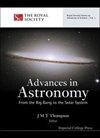Oceans, Lakes, and Stromatolites on Mars
IF 1.2
4区 物理与天体物理
Q3 ASTRONOMY & ASTROPHYSICS
引用次数: 8
Abstract
Billions of years ago, the Northern Hemisphere of Mars may have been covered by at least one ocean and thousands of lakes and rivers. These findings, based initially on telescopic observations and images by the Mariner and Viking missions, led investigators to hypothesize that stromatolite fashioning cyanobacteria may have proliferated in the surface waters, and life may have been successfully transferred between Earth and Mars via tons of debris ejected into the space following bolide impact. Studies conducted by NASA’s robotic rovers also indicate that Mars was wet and habitable and may have been inhabited in the ancient past. It has been hypothesized that Mars subsequently lost its magnetic field, oceans, and atmosphere when bolides negatively impacted its geodynamo and that the remnants of the Martian seas began to evaporate and became frozen beneath the surface. As reviewed here, twenty-five investigators have published evidence of Martian sedimentary structures that resemble microbial mats and stromatolites, which may have been constructed billions of years ago on ancient lake shores and in receding bodies of water, although if these formations are abiotic or biotic is unknown. These findings parallel the construction of the first stromatolites on Earth. The evidence reviewed here does not prove but supports the hypothesis that ancient Mars had oceans (as well as lakes) and was habitable and inhabited, and life may have been transferred between Earth and Mars billions of years ago due to powerful solar winds and life-bearing ejecta propelled into the space following the bolide impact.火星上的海洋、湖泊和叠层石
数十亿年前,火星的北半球可能被至少一个海洋和数千个湖泊和河流所覆盖。这些发现最初是基于水手号和海盗号任务的望远镜观测和图像,使研究人员假设叠层石形成的蓝藻可能在地表水中大量繁殖,生命可能已经成功地在地球和火星之间转移,通过在火流星撞击后喷射到太空中的大量碎片。美国国家航空航天局的机器人漫游者进行的研究也表明,火星是潮湿的,适合居住,而且在古代可能有人居住。有一种假说认为,火星随后失去了磁场、海洋和大气,因为火石对其地球发电机产生了负面影响,火星海洋的残留物开始蒸发,并在地表下冻结。正如本文所述,25位研究人员已经发表了火星沉积结构的证据,这些沉积结构类似于微生物席和叠层石,它们可能是数十亿年前在古老的湖岸和退缩的水体中形成的,尽管这些构造是非生物的还是生物的尚不清楚。这些发现与地球上第一批叠层石的形成相吻合。这里回顾的证据不能证明但支持这样的假设,即古代火星有海洋(以及湖泊),适合居住和居住,数十亿年前,由于强大的太阳风和携带生命的弹射物被推入太空,生命可能已经在地球和火星之间转移。
本文章由计算机程序翻译,如有差异,请以英文原文为准。
求助全文
约1分钟内获得全文
求助全文
来源期刊

Advances in Astronomy
ASTRONOMY & ASTROPHYSICS-
CiteScore
2.70
自引率
7.10%
发文量
10
审稿时长
22 weeks
期刊介绍:
Advances in Astronomy publishes articles in all areas of astronomy, astrophysics, and cosmology. The journal accepts both observational and theoretical investigations into celestial objects and the wider universe, as well as the reports of new methods and instrumentation for their study.
 求助内容:
求助内容: 应助结果提醒方式:
应助结果提醒方式:


